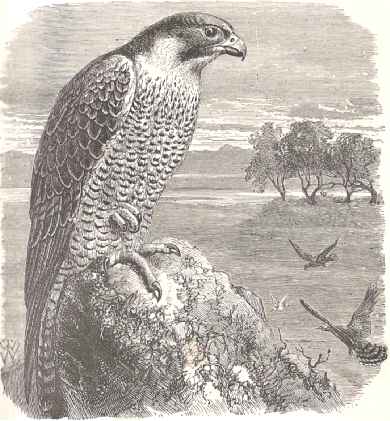
Harrier Hawks flying below a perched Peregrine Falcon
|
The name of harrier appears to be given to these birds on account of their habit of regularly quartering the ground
over which they fly when in search of prey, just like hounds when searching
for hares. This bird is essentially a haunter of flat and marshy lands,
where it finds frogs, mice, lizards, on which it usually feeds. It does
not, however, confine itself to such food, but will chase and kill most
of the smaller birds, and occasionally will catch even the leveret, the
rabbit, the partridge, and the curlew.
When it chases winged prey, it rarely seizes
the bird in the air, but almost invariably flies above it, and gradually
drives it to the ground. It will be seen, therefore, that its flight is
mostly low, as suits the localities in which it lives, and it seldom soars
to any great height, except when it amuses itself by rising and wheeling
in circles together with its mate. This display generally takes place before
nest-building. The usual flight is a mixture of that of the kestrel and
the falcon, the harrier sometimes poising itself over some particular spot,
and at other times, shooting forwards through the air with motionless wings.
Unlike the falcons and most of the hawks,
the harrier does not as a rule perch on rocks, but prefers to sit very upright
on the ground, perching generally on a mole-hill, stone, or some similar
elevation. Even its nest is made on the ground, and is composed of reeds,
sedges, sticks, and similar matter, materials that can be procured from
marshy land. The nest is always elevated a foot or so from the ground,
and has occasionally been found on the top of a mound more than a yard
in height. It is, however, conjectured that in such cases the mound is
made by one nest being built upon the remains of another. The object of
the elevated nest is probably to preserve the eggs in case of a flood.
At least five species of harriers are known
to exist in the Holy Land, two of which are among the British birds. These two are the Marsh harrier, sometimes called the Duck Hawk or the Moor Buzzard, and
also the Hen harrier which is sometimes called the White Hawk, Dove Hawk,
or Blue Hawk (on account of the plumage of the male which differs greatly
according to age) or the Ring-tailed Hawk (on account of the dark bars
which appear on the tail of the female). All the harriers are remarkable
for the circlet of feathers that surrounds the eyes, and which resembles
in a lesser degree the bold feather-circle around the eye of the owl tribe.
|





